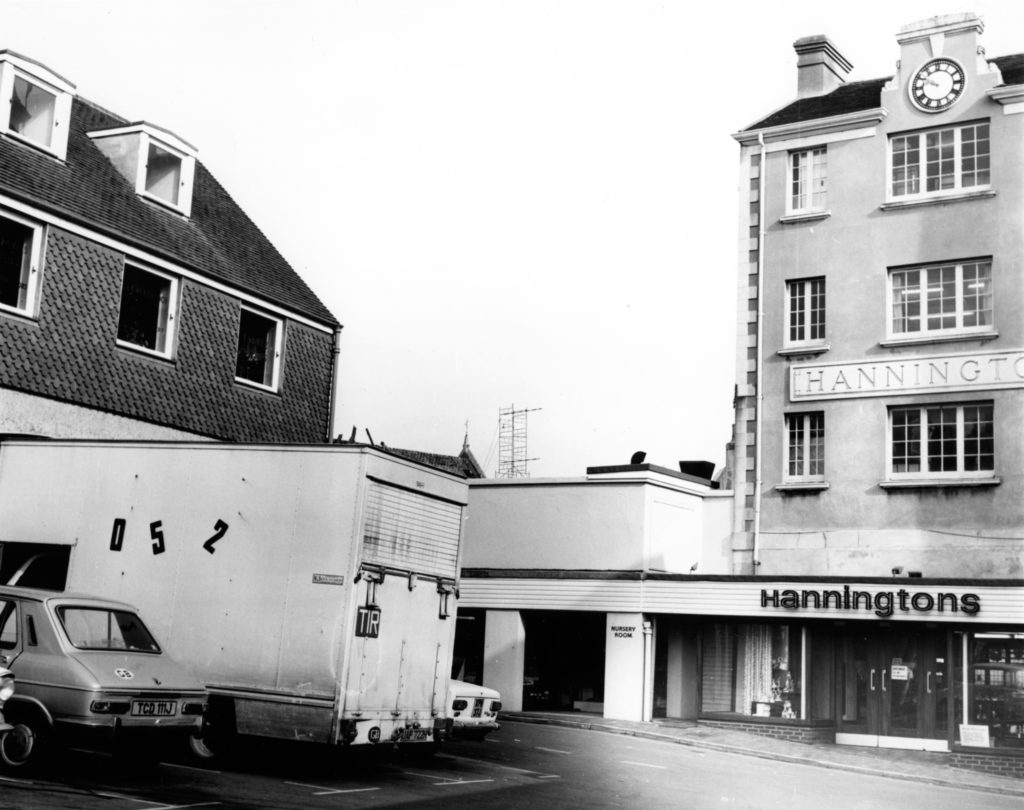Hanningtons: ‘Famed for Richness of Quality, Undoubted Reliability and Moderate Prices’
This is a legacy story from an earlier version of our website. It may contain some formatting issues and broken links.
On the corner of North Street and East Street, there are several buildings with pastel-and-white decoration on their upper floor facades. The lower floors are now home to a variety of different shops and cafés.
However, before 2001, the whole building was home to one store, known as the ‘Harrods of Brighton’.

Rear of Hannington’s buildings and a partial view of new development of Brighton Place and Square.
Hanningtons has a long and varied history stretching back to 25 July 1808, when its founder, Smith Hannington, opened a draper’s shop at 3 North Street. By the Regency period, the shop had expanded and in 1816 the store received a Royal Warrant from George IV. The royal connection meant that Hanningtons became known as the ‘Harrods of Brighton’.

View of the Countess of Huntingtons Chapel which was demolished in 1972. Hanningtons can be seen both next to and opposite to the church
In the first half of the nineteenth century, Hanningtons expanded further, pioneering the practice of using in-store concessions gradually becoming an early form of department store.
By 1862, Charles Hannington, Smith Hannington’s son, had taken over the business, and acquired two more buildings on North Street. He commissioned architect William Russell to unite all the North Street shop units into a single store with a common architectural theme – and Hannington’s storefront starts to become the building that we recognise today.

Smith Hannington c.1830.
The exterior of the building was not the only thing to change. In second half of the nineteenth century, Hanningtons began to face competition from other shops such as Knight and Wakefield’s and Vokins; in response, the business was forced to diversify. By the 1890s Hanningtons was offering funeral services alongside its regular retail staples such as clothing and millinery.
Moving into the early twentieth century, the business began to advertise its services in print publications, with one advertisement in the Brighton Season from 1920, describing how Hanningtons was ‘famed for Richness of Quality Undoubted Reliability and Moderate Prices’.

Paper bag from Hanningtons department store, Brighton, which as printed on the bag, was established in 1808.
The store moved out of family ownership in 1966 on the death of the last member of the Hannington family but continued to trade throughout the 1960s and 1970s. The late 1980s saw the beginning of a slow decline. Other independent department stores in Brighton began to close and the Hanningtons building suffered several fires.

Ruth Compton, a manageress at Hanningtons in the early 20th century.
The major redevelopment of Churchill Square, which opened in 1998, hastened the decline of Hanningtons. Central Brighton’s final independent department store simply could not compete, and the tills at the ‘Harrods of Brighton’ rang for the last time on 30 June 2001.
Naomi Daw, Visitor Service Officer